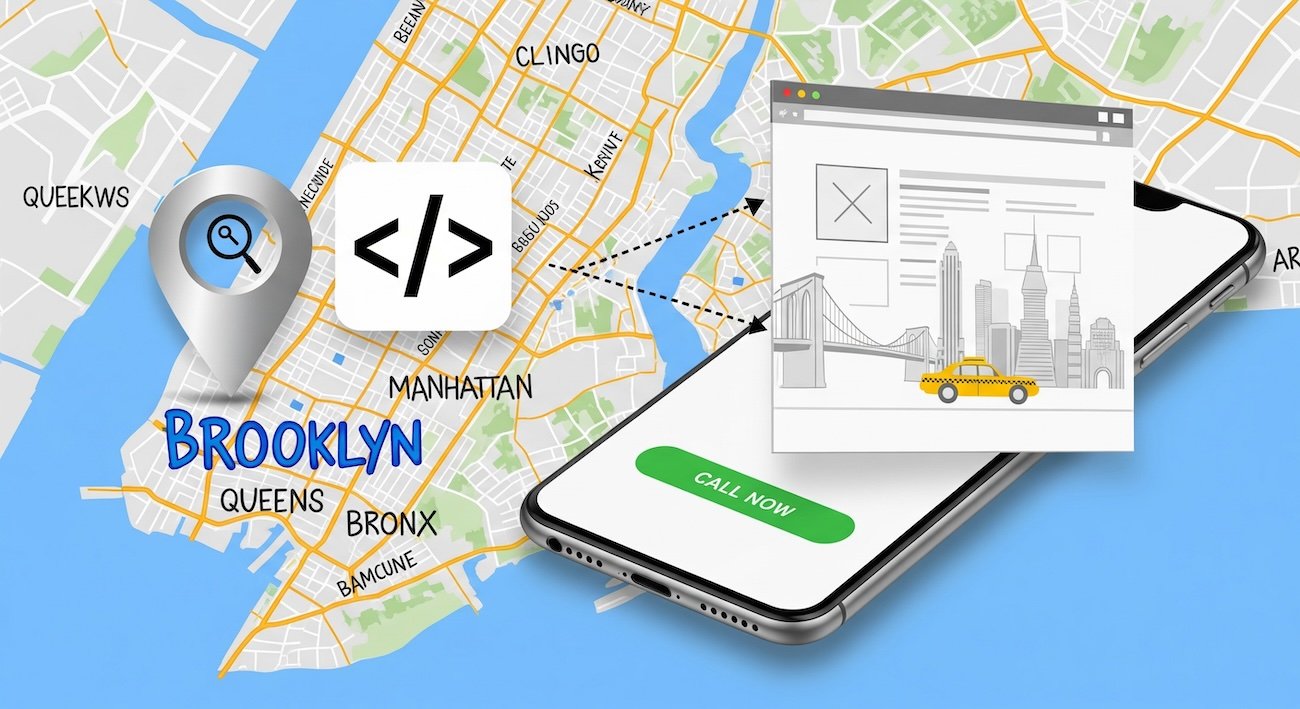In the world’s most competitive market, a stunning website alone won’t cut it. For New York City’s small businesses, capturing both online and foot traffic requires combining eye-catching design with hyper-targeted local SEO tactics. This guide unveils seven in-depth strategies—complete with real NYC case studies, actionable checklists, and insider tips—that turn neighborhood browsers into loyal customers. Strap in, because your website is about to become the hottest digital destination in the boroughs.
1. Neighborhood Targeting: Craft Borough-Specific Pages
Broad keywords like “NYC web design” face steep competition. Instead, create dedicated landing pages tailored to each borough and key neighborhood. This hyperlocal approach ensures you rank for searches most relevant to your exact service area.
Implementation Steps:
- Keyword Research
- Use tools like Ahrefs or SEMrush to identify high-volume, low-difficulty keyword phrases such as “Brooklyn bakery web design” or “Chelsea café website designer.”
- Focus on long-tail modifiers: street names, landmarks, and ZIP codes.
- Geo-Focused Headlines & Meta Tags
- Headlines: “Award-Winning Web Design for Williamsburg Coffee Shops.”
- Meta Description: “Top-rated Brooklyn bakery web design agency boosting local foot traffic.”
- Localized Content Blocks
- Embed Google Maps iframes highlighting your exact location.
- Include neighborhood testimonials: “Our Park Slope clients praised us for same-day updates.”
- Technical Optimization
- Use hreflang or canonical tags only if you publish multiple language variants.
- Ensure each page has unique title tags, meta descriptions, and URL slug (e.g., /brooklyn-bakery-web-design).
Case Study: Adele’s Bakery, a Bushwick institution, launched separate pages for “Bushwick Bakery Web Design” and “Williamsburg Café Web Design.” Within two months, organic sessions from each neighborhood rose by 60% and 45% respectively, leading to a 30% increase in local orders.
2. Google My Business Mastery: Leverage Every Feature
Most small businesses set up their Google My Business (GMB) profile and never touch it again. Exceptional brands use GMB as a dynamic marketing channel that drives both local visibility and conversions.
Advanced GMB Tactics:
- Weekly GMB Posts
- Share promotions, events, or new blog posts.
- Use engaging visuals and CTAs like “Book Now” or “View Menu.”
- Q&A Seeding
- Proactively add common customer questions (“Do you offer vegan pastries?”) and answer them.
- Encourage your team to monitor and respond within 24 hours to all new queries.
- Location-Specific Reviews
- Incentivize customers to mention neighborhood landmarks (e.g., “Best design near Central Park”).
- Respond to every review—positive and negative—to show responsiveness.
- Product & Service Attributes
- Add relevant attributes such as “Offers Online Appointments” or “Wheelchair Accessible.”
Real-World Impact: Midtown Yoga Co. optimized their GMB with weekly class updates and Q&A, driving a 35% surge in “yoga near me” searches and a 20% rise in bookings over six weeks.
3. Localized Schema Markup: Build Digital Blueprints
Structured data serves as a blueprint for search engines, helping them understand your business and display rich results. Proper implementation boosts visibility in the Local Pack and Knowledge Panel.
Essential JSON-LD Schemas:
- LocalBusiness Schema
Include NAP (Name, Address, Phone), business hours, geo-coordinates, and logo URL. - Service Schema
Detail specific services (e.g., “custom Shopify design,” “e-commerce web design”). - Review Schema
Display average rating and review count directly in search results. - BreadcrumbList
Help users and search engines navigate your site hierarchy.
Implementation Tips:
- Generate schema snippets using Google’s Structured Data Markup Helper.
- Validate with the Rich Results Test.
- Embed the JSON-LD code in the
<head>section of each neighborhood page.
Result: Businesses using localized schema have seen up to a 25% increase in rich result impressions and a significant lift in click-through rates.
4. NAP Consistency Audit: Cement Your Citations
Inconsistent Name, Address, Phone (NAP) data undermines local rankings. A thorough audit across major directories ensures Google trusts your business signals.
NAP Audit Checklist:
| Directory | Name Format | Address Format | Phone Format | Status |
|---|---|---|---|---|
| Google My Business | Adele’s Bakery | 123 Bedford Ave, Brooklyn NY | (718) 555-0198 | Verified |
| Yelp | Adele’s Bakery | 123 Bedford Avenue, Brooklyn NY | 718-555-0198 | Updated |
| Adele’s Bakery | 123 Bedford Ave, Brooklyn, NY | +1-718-555-0198 | Reviewed | |
| YellowPages | Adele’s Bakery | 123 Bedford Ave Brooklyn NY | 7185550198 | Updated |
| Bing Places | Adele’s Bakery | 123 Bedford Avenue, Brooklyn NY | 718-555-0198 | Verified |
Steps:
- List all citation sources (20+).
- Standardize your business name and formatted address.
- Update discrepancies manually or via citation management tools like Moz Local.
Outcome: Completing a NAP audit can reduce citation errors by 90%, strengthening local SEO foundations and improving map pack rankings.
5. Hyperlocal Content Strategy: Become Every Block’s Authority
Position your site as the go-to resource for neighborhood insights and services. Publish hyperlocal guides, blog posts, and interactive maps that resonate with area residents.
Content Ideas:
- “Top 5 Late-Night Bakeries in Williamsburg”
- “A Complete Guide to Wedding Venues in DUMBO”
- “How to Launch a Pop-Up Shop on Bleecker Street”
- Interactive map showing featured local businesses and landmarks
Best Practices:
- Integrate internal links back to your service pages (e.g., “Learn how our web design services helped Greene Avenue Café”).
- Solicit guest contributions from neighborhood influencers to earn backlinks.
- Promote via local Facebook groups and Nextdoor.
Case Study: A Flushing real-estate agent published a “Queens Weekend Market Guide” and secured backlinks from community blogs, resulting in a 50% spike in qualified leads within a month.
6. Optimize Mobile UX: Design for the On-the-Go New Yorker
With 80% of local searches occurring on mobile, your site must deliver lightning-fast load times and intuitive navigation for users on the move.
Mobile UX Priorities:
- Speed Optimization
- Aim for a First Contentful Paint under 1.8 seconds.
- Compress images with next-gen formats (WebP, AVIF).
- Click-to-Call Integration
- Place “Call Now” buttons in the sticky header.
- Use tel: links for one-tap dialing.
- Sticky Map Icon
- Implement a persistent map icon that opens Google Maps with a single tap.
- Progressive Disclosure Forms
- Reveal one form field at a time to reduce friction and boost completion rates.
Impact: After adding a sticky call button and optimizing images, an Upper West Side chiropractor saw phone inquiries double within four weeks.
7. Local Backlink Ecosystem: Partner and Prosper
Forge strategic partnerships with complementary neighborhood businesses to co-create content and exchange backlinks.
Tactics:
- Guest Blogging Exchanges
- A Tribeca café writes a post for a nearby art gallery’s blog on “Designing Café Interiors.”
- The gallery reciprocates with a post on your site about “Curating Art in Café Spaces.”
- Cross-Promotion Campaigns
- Host joint events or webinars and share landing pages linking to each other.
- Local Sponsorships
- Sponsor a block party or charity run, then request a backlink from the event’s website.
Result: A Harlem barber who co-hosted a style event with a local fashion boutique earned authoritative .edu and .org backlinks, boosting organic rankings for barber-related keywords by 40%.
Bringing It All Together: The Five-Step Workflow
- Perform Borough-Specific Keyword Research
- Identify 5–10 target phrases per neighborhood.
- Optimize GMB and Implement Schema
- Update posts weekly and embed JSON-LD on each page.
- Complete a NAP Consistency Audit
- Standardize citations across 20+ platforms.
- Publish Hyperlocal Content
- Publish at least two neighborhood guides per month.
- Build Local Partnerships
- Secure at least five high-quality local backlinks quarterly.
Following this workflow elevates your small-business website from a generic presence to a thriving local hub—capturing both digital and walk-in traffic across NYC’s vibrant neighborhoods.
Conclusion
New York City’s neighborhoods are dynamic, diverse, and brimming with opportunity. By mastering these seven local SEO strategies—neighborhood targeting, Google My Business mastery, localized schema markup, NAP consistency, hyperlocal content creation, mobile UX optimization, and building a local backlink ecosystem—you’ll transform your small-business website into a community landmark that both visitors and search engines love. Ready to dive deeper into conversion psychology? Unlock the Psychology Behind High-Converting Landing Pages: Insider Tactics Revealed today. For expert web design tailored to your NYC business, partner with PerfectPixel Digital Agency at Affordable Web Design. Want to get started? Get your free quote now and let us build your next masterpiece.






